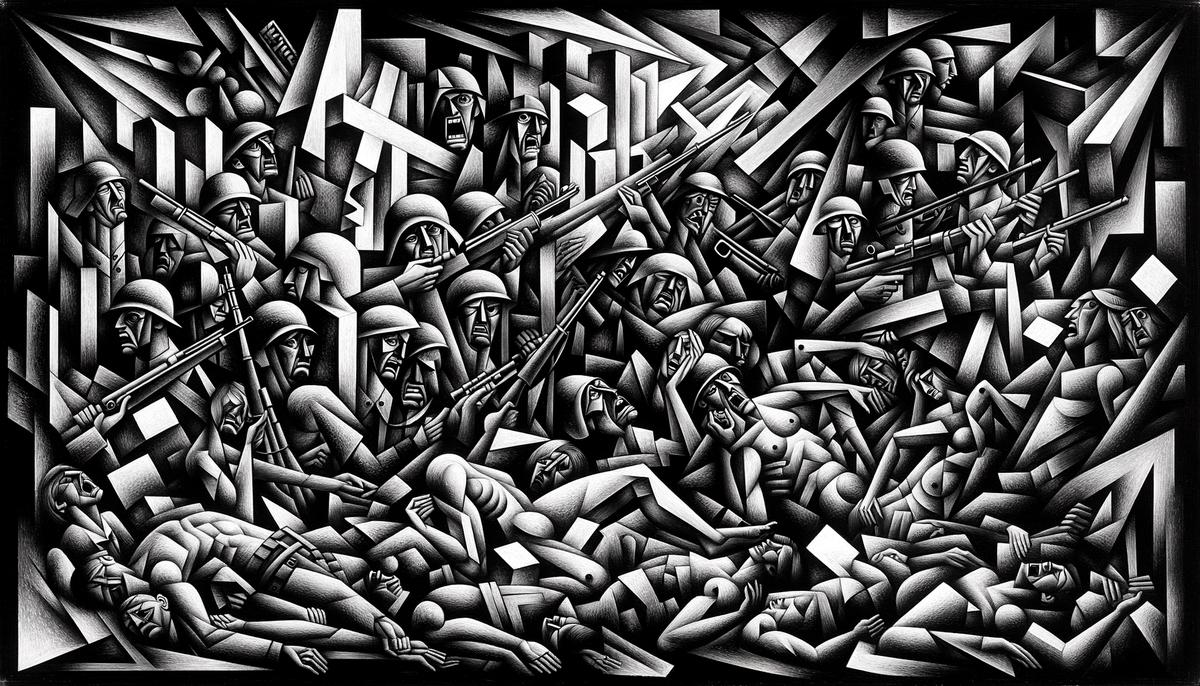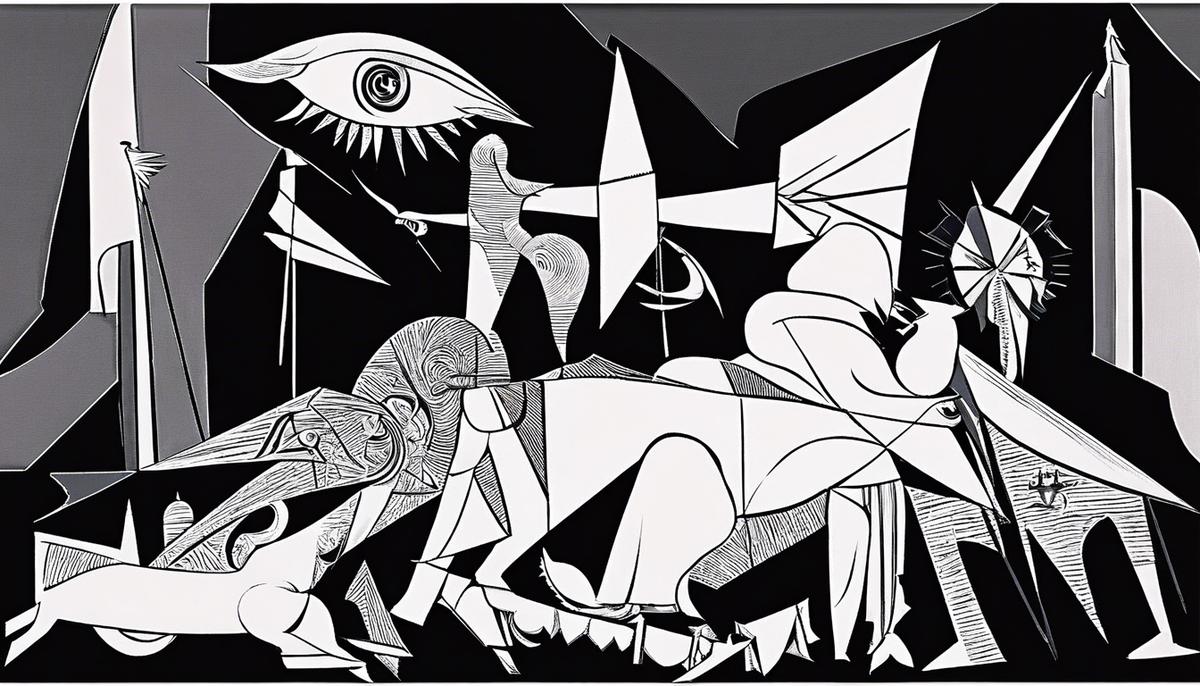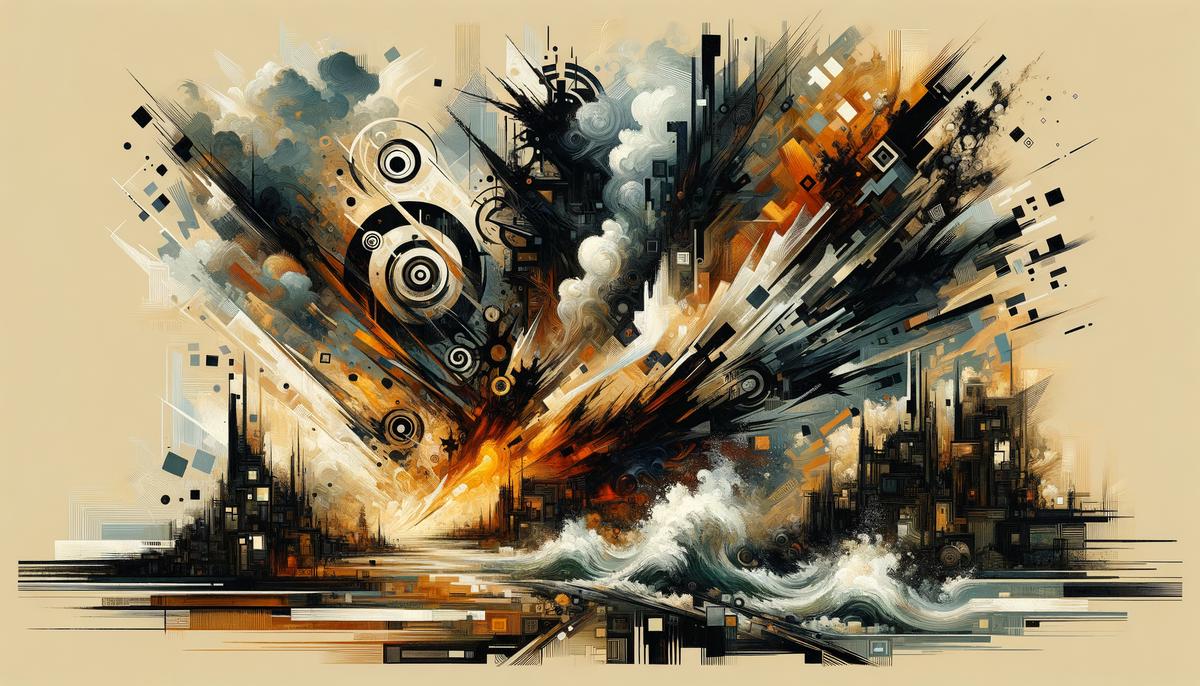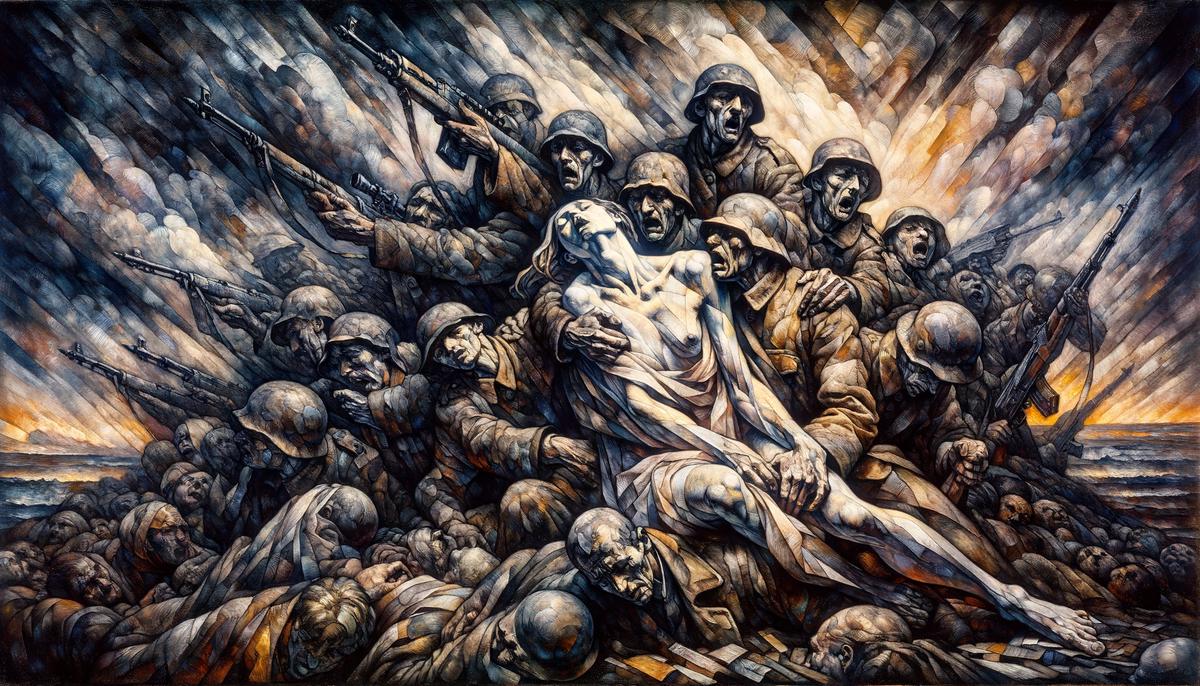At the crux of the 20th century’s artistic and historical discourse stands Pablo Picasso’s “Guernica,” a painting not only defined by its era but also transcending it to speak universal truths about war, peace, and human empathy. This article seeks to unravel the layers of meaning embedded within “Guernica,” exploring its creation, the symbols it houses, its profound impact on art and society, and its enduring relevance in modern times. By examining the weaving of political fervour with artistic innovation, we will understand how “Guernica” continues to serve as a powerful testament to the role of art in reflecting and shaping human consciousness.
Historical Context of Guernica
In the heart of the 20th century, the world witnessed the eruption of the Spanish Civil War, a conflict that would leave indelible marks on the canvas of history and inspire one of the most powerful artworks of modern times: Pablo Picasso’s Guernica. This masterpiece is not just a painting; it is a manifestation of the horrors of war and a timeless plea for peace. The story behind Guernica’s creation is a poignant reminder of the devastating impact of conflict on innocent lives and the power of art to convey profound messages.
On April 26, 1937, during the height of the Spanish Civil War, the small Basque town of Guernica became the target of a brutal aerial bombardment by the German Luftwaffe’s Condor Legion and the Italian Aviazione Legionaria, acting in support of Francisco Franco’s Nationalist forces. This assault was not merely a military operation but an experiment in terror bombing, aimed at demoralizing the enemy and breaking the will of the Basque people, who were staunch supporters of the Republican government. The attack obliterated the town, causing unprecedented destruction and loss of civilian life. The world was shocked by the barbarity of the bombardment, which served as a grim prelude to the widespread aerial warfare that would characterize World War II.
Picasso, living in Paris at the time, was profoundly affected by the news of the Guernica tragedy. Commissioned to create a mural for the Spanish Pavilion at the 1937 Paris World’s Fair, he found his subject. Shifting away from his initial ideas, Picasso poured his anguish and outrage into a monumental canvas that captured the essence of the pain, chaos, and suffering inflicted by the bombing. Guernica is a stark, black-and-white testament to the horrors of war, devoid of color as if to mirror the bleakness of the event it represents. Through its disjointed and distorted figures—including a grieving mother holding her dead child, a fallen warrior, and a terrified horse—Picasso communicates the sense of fear, agony, and despair experienced by the victims.
The painting transcends its immediate historical context to become a universal symbol of the atrocities of war. Guernica challenges viewers to confront the impacts of conflict and the inherent destructiveness of mankind’s inhumanity to its own. It stands as a powerful statement against the brutality of war and an eloquent plea for peace, reflecting Picasso’s belief in the ability of art to bear witness to the truth and to effect change in the world.
In creating Guernica, Picasso melded political engagement with artistic innovation, demonstrating the potential of art to respond to historical events and to catalyze social and political reflection. Guernica remains one of the most moving and influential anti-war artworks ever created, a haunting reminder of the tragedy of Guernica and the enduring human capacity for both destruction and empathy. Through this masterpiece, Picasso invites us to reflect on the past, consider the implications of war, and aspire to a future where such atrocities are consigned to history.

Analyzing the Symbolic Elements in Guernica
Diving into the heart of Picasso’s masterpiece, “Guernica”, we uncover a labyrinth of symbols, each echoing the tragedies of war and the cries for peace. Amongst its stark monochrome palette, symbols emerge with profound meanings, narrating stories louder than words ever could. Let’s embark on a journey to decode these symbols, revealing the depth of Picasso’s cry against the brutality of war.
Central to the sprawling chaos of the painting is a gored horse. This creature, pained and disheveled, stands not just as a victim of the violence, but as a powerful emblem of the people’s suffering. Throughout history, horses have symbolized freedom and vitality, yet here, the horse’s agony underlines the crushing blow to liberty and life inflicted by the conflict. There’s an undeniable parallel between the horse’s torment and the devastation endured by the innocent citizens of Guernica.
Hovering above the horse, a bull looms, its presence commanding and complex. Unlike the horse, the bull appears less visibly distressed, stirring debates among interpreters about its significance. Some view the bull as a symbol of Spain’s cultural identity—stoic and resilient in the face of devastation. Others argue it represents the brutality and darkness of the warring forces, overseeing the chaos below with a chilling detachment. This duality invites viewers to ponder the multifaceted nature of war itself—both a destroyer and a definer of identities.
A stricken female figure cradles a lifeless child in her arms, a motif reminiscent of a pieta, evoking themes of loss and mourning. This heartbreaking scene transcends the specific context of Guernica, reaching into the universal anguish of all mothers in war’s wake. Her outcry pierces through the ages, uniting the pain of countless who have lost loved ones to the senseless tides of war.
In the midst of despair, a glimmer of hope—or perhaps a warning—is cast by the light bulb blazoned at the top center of the canvas, ominously situated near the bull. This “eye of the electric light” eerily illuminates the scene, suggesting the destructive power of technology in modern warfare. Yet, it could also be interpreted as a beacon of enlightenment, urging the world to awaken to the horror of war and strive for peace.
Another poignant figure is the woman trapped in the burning building, her arm extended in a desperate plea for rescue, while flames engulf her. This harrowing image starkly illustrates the entrapment and helplessness faced by civilians, their homes and lives razed by warfare’s unforgiving hand. It’s a chilling reminder of war’s capacity to invade the most personal of spaces, turning sanctuary into ashes.
A warrior lies dismembered, his broken sword beside him—a stark emblem of defeat. This fallen soldier symbolizes the futility of war, the lost lives and broken dreams in its aftermath. The shattered weapon, once a symbol of strength, now lies useless, underscoring the ultimate ineffectiveness of violence in resolving disputes.
Together, these symbols weave a tapestry of grief, despair, and a longing for peace within the chaos of “Guernica”. Picasso masterfully employs these motifs to not only depict the specific tragedy of Guernica but to also comment on the universal horrors of war. Through “Guernica”, Picasso challenges us to reflect on the destructive legacy of wars and the enduring need for peace in a turbulent world. The painting remains a potent reminder of art’s power to bear witness, to remember, and to urge humanity towards a more compassionate, peaceful existence.

Guernica’s Influence on Art and Society
In exploring the profound impact of Pablo Picasso’s masterpiece, “Guernica,” on global art and societal views regarding war, it’s essential to delve into the manner in which this monumental artwork traversed the confines of the art world to echo a powerful message across the globe. This painting not only marked a pivotal moment in Picasso’s career but also in the evolution of art as a form of political and social commentary.
“Guernica” emerged in an era where the world was on the brink of immense conflict, serving as a harbinger of the horrors that modern warfare would unleash on humanity. Its stark, monochromatic scheme—deliberately chosen by Picasso—eschews the vibrancy typically associated with his work, instead opting for a raw, poignant delivery of the chaos and suffering war inflicts.
The mural-sized canvas transcended traditional artistic boundaries, encapsulating a narrative both specific in its reference to the tragic bombing of Guernica and universal in its condemnation of war’s brutality. By doing so, Picasso leveraged “Guernica” as a platform to challenge societal desensitization towards violence. The painting’s touring exhibition further amplified its impact, transforming it into a symbol of peace and resistance against tyranny and oppression worldwide.
In the realm of art history, “Guernica” stands as a testament to the shift towards socially engaged art in the 20th century. Picasso’s melding of Cubist, Surrealist, and symbolic elements in “Guernica” opened new avenues for artists to explore themes of conflict, human rights, and social justice. It demonstrated art’s capacity to transcend aesthetic pleasure, acting as a catalyst for social change and dialogue.
Moreover, “Guernica’s” global resonance significantly influenced the perception of art’s role in society, positioning artists as potent commentators on political and societal issues. The mural’s evocative imagery sparked conversations on the need for a collective memory in the wake of tragedy, urging societies to confront and reflect upon the consequences of war rather than turn a blind eye.
In educational contexts, “Guernica” has become a crucial tool for teaching about the atrocities of war and the importance of peace, reinforcing art’s role in education and moral reflection. Its inclusion in academic curricula around the world underscores the necessity of confronting uncomfortable truths through art, fostering empathy, critical thinking, and an understanding of history’s cyclic nature.
On a broader scale, “Guernica” propelled the notion of art as a universal language capable of bridging cultural, linguistic, and geographical divides. Its emotional depth and symbolic complexity invite interpretation and engagement from diverse audiences, highlighting art’s unique ability to unite people through shared human experiences.
In conclusion, Pablo Picasso’s “Guernica” not only redefined the boundaries of art’s societal impact but also solidified its place in history as an enduring symbol of peace and a powerful indictment of war’s devastating toll on humanity. Through this masterpiece, art assumed a dynamic role in shaping public consciousness, advocating for peace, and challenging the societal norms that condone violence. “Guernica” remains a poignant reminder of art’s transformative power, echoing across generations the undiminished plea for humanity to choose peace over war.

Guernica in Modern Times: Interpretations and Locations
In the journey of “Guernica,” from its creation to its place in modern society, we find an evolution of interpretation and a broadening of its impact. This painting, once a poignant response to a specific historical event, has transcended its origins to become a global emblem of peace, an echo chamber of humanity’s cry against the ravages of conflict.
“Guernica’s” role in Picasso’s career cannot be understated. It marked a radical shift, spotlighting societal issues through art. Picasso leveraged his mastery to channel a collective angst, using stark monochromatic tones to etch the horrors of war into the canvas of public consciousness. This choice of a black-and-white palette strips the scene of any romanticism, leaving viewers to confront the raw, unfiltered essence of terror and despair – a technique that amplifies “Guernica’s” narrative power and its universal condemnation of war’s brutality.
The touring exhibition of “Guernica” played a pivotal role in maximizing its impact, allowing people across the globe to witness and be moved by its powerful imagery. This not only transformed “Guernica” into a symbol of international peace but also catalyzed a shift toward socially engaged art in the 20th century. Artists began to see their work as not just an expression of aesthetic endeavor but as a vehicle for social commentary, influencing the perception of art’s role in society. They started to embrace the position of commentators on political and societal issues, understanding the potency of art in stirring dialogue, reflection, and change.
“Guernica” has also found a significant place in educational contexts, serving as a profound teaching tool that transcends academic disciplines. It opens discussions on history, politics, ethics, and art, illustrating the interconnectedness of these fields and the importance of holistic learning. Through this, the painting bridges cultural, linguistic, and geographical divides, speaking a universal language that resonates with a timeless relevance.
This enduring significance of “Guernica” as a symbol of peace and an indictment of war’s toll on humanity is a testament to the transformative power of art. It stands as a plea for humanity to choose peace over war, compassion over cruelty. In today’s era, where conflicts and divisions seem increasingly insurmountable, “Guernica” remains not just a reminder of the past but a beacon for the future. It challenges us, urging us to reflect on the consequences of our actions and the world we aspire to create. In its silence lies a relentless echo, a reminder that amidst our tumultuous existence, art bears the capacity to unite, inspire, and propel us toward a more empathetic, peaceful world.

The narrative of “Guernica” does more than recount a historical event or display Picasso’s disdain for war; it encapsulates the artist’s deep-seated belief in the capacity of art to challenge, communicate, and catalyse change. As we reflect on “Guernica’s” journey from a response to the bombing of a small Basque town to a global symbol of peace, its message resonates with profound clarity today. The painting’s stark imagery, imbued with symbols of suffering and hope, continues to prompt introspection on the nature of conflict and the universal yearning for peace. Thus, “Guernica” remains not just an artifact of history but a living call to humanity, urging us towards compassion, understanding, and, ultimately, a reimagining of our world where peace prevails over the spectre of war.























